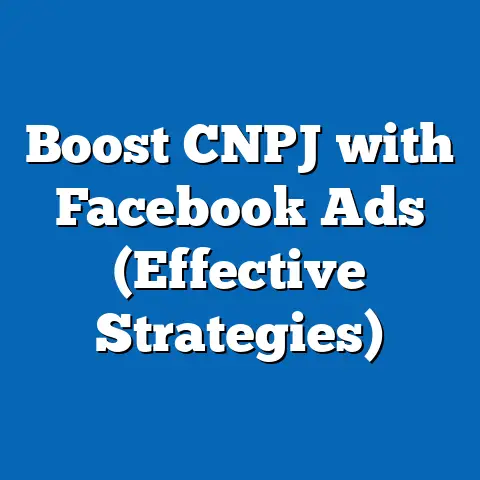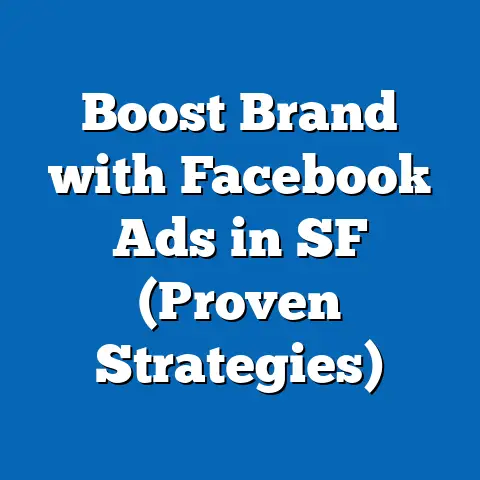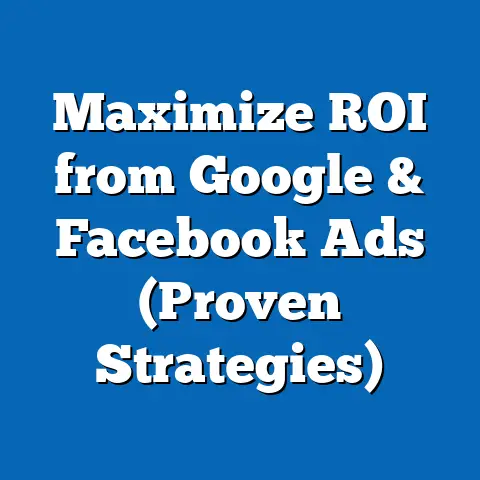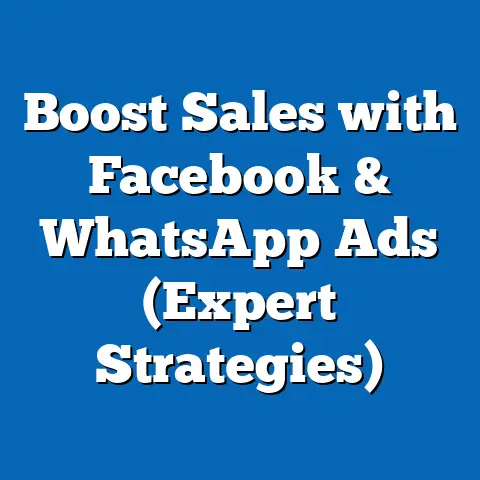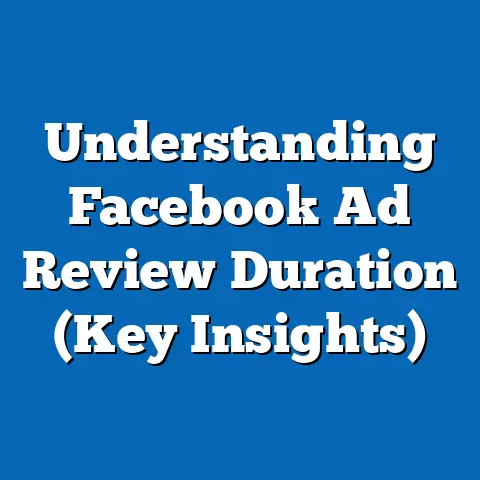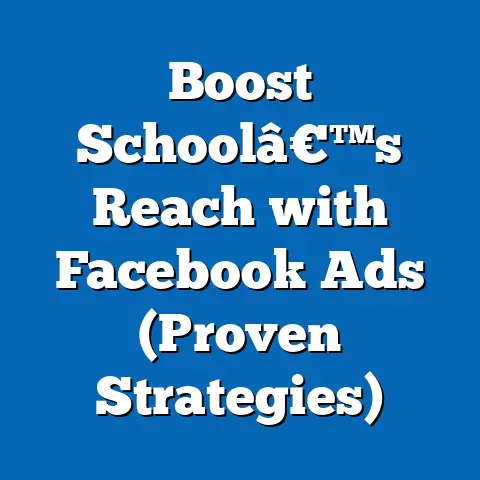Domina Cómo Hacer Facebook Ads (Strategic Success Tips)
In today’s digital marketplace, a strong online presence is more than just a nice-to-have – it’s a necessity. And when it comes to reaching a massive and diverse audience, Facebook Ads remain a powerhouse. But let’s be honest, throwing money at Facebook and hoping for the best rarely works. To truly dominate the platform, you need a strategic approach. Think of your Facebook Ads as an investment, not just in clicks and likes, but in the long-term resale value of your business.
I’ve seen firsthand how a well-executed Facebook Ads strategy can transform a struggling business into a thriving one. It’s not just about getting more customers; it’s about building brand awareness, fostering customer loyalty, and ultimately, increasing your company’s overall worth. When potential investors or buyers see a business with a strong, engaged online community driven by effective advertising, they see a business with staying power.
Take, for example, a local bakery I worked with. They were struggling to compete with larger chains in their area. By implementing a targeted Facebook Ads campaign that showcased their unique artisanal breads and pastries, they not only attracted new customers but also cultivated a loyal following. This increased visibility and engagement translated into a significant boost in revenue, making the bakery a much more attractive acquisition target.
Section 1: Understanding Facebook Ads
Facebook Ads are a powerful tool that allows businesses to reach a vast audience on the world’s largest social media platform. But before you start throwing money around, it’s crucial to understand how they work and what options are available.
At its core, Facebook Ads is a pay-to-play system. You create ads, set a budget, and target specific demographics and interests. Facebook then displays your ads to users who match your criteria. When users interact with your ads (by clicking, liking, or sharing), you pay Facebook a fee.
The beauty of Facebook Ads lies in its incredible targeting capabilities. You can target users based on:
- Demographics: Age, gender, location, education, relationship status, etc.
- Interests: Hobbies, passions, favorite brands, pages they like, etc.
- Behaviors: Purchase history, online activity, devices used, etc.
- Connections: People who like your page, friends of people who like your page, etc.
This level of granularity allows you to pinpoint your ideal customer with laser-like precision, ensuring that your ads are seen by the people most likely to be interested in your products or services.
But simply targeting the right audience isn’t enough. You also need to choose the right ad format. Facebook offers a variety of ad formats, each with its own strengths and weaknesses:
- Image Ads: Simple and effective for showcasing products or services with a visually appealing image.
- Video Ads: Engaging and dynamic for telling stories and capturing attention. Video ads are booming right now, so don’t be afraid to experiment!
- Carousel Ads: Allow you to showcase multiple products or services in a single ad unit.
- Collection Ads: Ideal for e-commerce businesses, allowing users to browse and purchase products directly from the ad.
- Lead Ads: Designed to collect leads directly from Facebook, making it easy for users to sign up for newsletters or request more information.
- Instant Experience Ads: Full-screen, mobile-optimized experiences that allow users to interact with your brand in a more immersive way.
Choosing the right ad format depends on your specific goals and target audience. For example, if you’re trying to generate leads, Lead Ads might be the best option. If you’re trying to showcase a variety of products, Carousel Ads could be more effective.
Key Takeaway: Understanding the basics of Facebook Ads, including its targeting capabilities and ad formats, is crucial for creating effective campaigns.
Section 2: Setting Clear Objectives
Before you even think about creating an ad, you need to define your objectives. What do you want to achieve with your Facebook Ads campaign? Are you trying to increase brand awareness, generate leads, drive website traffic, or boost sales?
Setting clear objectives is crucial for several reasons:
- It helps you define your target audience: Knowing what you want to achieve will help you identify the people most likely to be interested in your products or services.
- It guides your ad creation: Your objectives will influence the content, format, and call to action of your ads.
- It allows you to measure your success: Without clear objectives, it’s impossible to determine whether your campaign is actually working.
Here are some common Facebook Ads objectives:
- Brand Awareness: Increase awareness of your brand among a specific target audience. This is often used for new businesses or product launches.
- Reach: Show your ad to the maximum number of people within your target audience. This is a good option for businesses with a broad target market.
- Traffic: Drive traffic to your website or landing page. This is often used to generate leads or drive sales.
- Engagement: Increase engagement with your Facebook page or posts (likes, comments, shares). This is a good option for building brand loyalty and fostering community.
- Lead Generation: Collect leads directly from Facebook. This is often used for businesses that offer services or products with a longer sales cycle.
- App Installs: Drive downloads of your mobile app.
- Video Views: Increase the number of views on your video ads.
- Conversions: Drive specific actions on your website, such as purchases, sign-ups, or form submissions. This is the ultimate goal for many businesses.
- Catalog Sales: Drive sales of products from your Facebook catalog.
- Store Traffic: Drive foot traffic to your physical store location.
Each objective requires a different strategy. For example, if your objective is brand awareness, you’ll want to focus on creating visually appealing ads with a clear message. If your objective is conversions, you’ll want to focus on creating ads with a strong call to action and a seamless user experience.
Key Takeaway: Defining clear objectives is the foundation of any successful Facebook Ads campaign. Choose objectives that align with your overall business goals and use them to guide your ad creation and targeting.
Section 3: Crafting Compelling Ad Content
Once you’ve defined your objectives and target audience, it’s time to create compelling ad content that captures attention and drives results. Your ad copy, visuals, and call to action are the key ingredients for a successful ad.
Here are some tips for crafting effective ad copy:
- Write clear and concise headlines: Your headline is the first thing people will see, so make it count. Use strong verbs and highlight the benefits of your product or service.
- Use persuasive language: Appeal to your target audience’s emotions and desires. Use words that evoke feelings of excitement, urgency, or exclusivity.
- Highlight the benefits, not just the features: Tell people how your product or service will improve their lives.
- Keep it short and sweet: People have short attention spans, so get to the point quickly.
- Use a strong call to action: Tell people what you want them to do (e.g., “Shop Now,” “Learn More,” “Sign Up Today”).
Your visuals are just as important as your ad copy. Here are some tips for creating visually appealing ads:
- Use high-quality images and videos: Blurry or pixelated images will turn people off.
- Choose visuals that are relevant to your target audience: Use images and videos that resonate with their interests and desires.
- Use bright colors and bold designs: Make your ads stand out from the crowd.
- Use images of people: People are naturally drawn to faces.
- Keep it simple: Don’t overcrowd your ads with too many elements.
Storytelling is a powerful tool for creating an emotional connection with potential customers. Instead of simply listing the features of your product or service, tell a story about how it can help them solve a problem or achieve a goal.
I once worked with a travel agency that was struggling to attract new customers. We created a series of video ads that told the stories of real people who had taken amazing trips with the agency. These ads were incredibly effective because they allowed potential customers to imagine themselves experiencing the same adventures.
Key Takeaway: Crafting compelling ad content requires a combination of persuasive copy, visually appealing visuals, and strategic storytelling. Focus on highlighting the benefits of your product or service and creating an emotional connection with your target audience.
Section 4: Targeting the Right Audience
As I mentioned earlier, Facebook’s targeting capabilities are one of its greatest strengths. But simply having access to these tools isn’t enough. You need to know how to use them effectively.
Audience segmentation is the key to successful targeting. This involves dividing your target audience into smaller groups based on their demographics, interests, behaviors, and connections. This allows you to create ads that are highly relevant to each segment, increasing the likelihood that they will engage with your ads.
Facebook offers several tools for creating custom audiences:
- Custom Audiences: Allow you to target people who have already interacted with your business, such as website visitors, email subscribers, or app users. This is a powerful way to retarget people who are already familiar with your brand.
- Lookalike Audiences: Allow you to target people who are similar to your existing customers. This is a great way to expand your reach and find new customers who are likely to be interested in your products or services.
- Saved Audiences: Allow you to target people based on their demographics, interests, behaviors, and connections. This is a good option for targeting a broad audience with specific characteristics.
Retargeting is a particularly effective strategy. This involves showing ads to people who have already visited your website or interacted with your business in some way. For example, you could show ads to people who have added items to their cart but haven’t completed their purchase. Retargeting is a great way to remind people about your products or services and encourage them to take action.
Let’s say you’re selling running shoes. You could create a custom audience of people who have visited your website’s running shoe page. Then, you could create a retargeting ad that shows them the specific running shoes they were looking at, along with a special offer or discount. This is a much more effective way to reach potential customers than showing them generic ads for running shoes.
Key Takeaway: Audience segmentation and retargeting are crucial for maximizing the effectiveness of your Facebook Ads campaigns. Use Facebook’s audience insights tools to identify your ideal customer and create targeted ads that resonate with their interests and needs.
Section 5: Budgeting and Bidding Strategies
Setting the right budget and choosing the right bidding strategy are essential for maximizing your ROI. You don’t want to spend too much money on ads that aren’t performing well, but you also don’t want to limit your reach unnecessarily.
The appropriate budget for your Facebook Ads campaign depends on several factors, including your business goals, target audience size, and competition. Here are some tips for setting your budget:
- Start small and scale up: Don’t start with a huge budget right away. Start with a small budget and gradually increase it as you see results.
- Set a daily budget: This will help you control your spending and prevent you from overspending.
- Use lifetime budgets: This allows you to set a total budget for your campaign and let Facebook optimize your spending over the entire period.
- Consider your target audience size: The larger your target audience, the more you’ll need to spend to reach them effectively.
- Research your competition: See how much your competitors are spending on Facebook Ads. This can give you a sense of what it takes to compete in your industry.
Facebook offers several bidding strategies:
- Cost Per Click (CPC): You pay each time someone clicks on your ad. This is a good option for driving traffic to your website or landing page.
- Cost Per Thousand Impressions (CPM): You pay each time your ad is shown to 1,000 people. This is a good option for increasing brand awareness.
- Cost Per Action (CPA): You pay each time someone takes a specific action, such as making a purchase or signing up for a newsletter. This is a good option for driving conversions.
- Automatic Bidding: Facebook automatically sets your bids to get the most results for your budget. This is a good option for beginners.
- Manual Bidding: You manually set your bids for each ad. This gives you more control over your spending, but it also requires more expertise.
Monitoring and adjusting your bids is crucial for optimizing your ad spend. Pay attention to your ad performance metrics and adjust your bids accordingly. If your ads are performing well, you can increase your bids to reach more people. If your ads aren’t performing well, you can decrease your bids or pause your campaign altogether.
Key Takeaway: Setting the right budget and choosing the right bidding strategy are crucial for maximizing your ROI. Start small and scale up, consider your target audience size, and monitor and adjust your bids based on your ad performance.
Section 6: Analyzing and Optimizing Campaign Performance
Tracking your ad performance is essential for determining whether your campaigns are working and for identifying areas for improvement. Facebook Ads Manager provides a wealth of data about your ad performance, including impressions, clicks, click-through rates (CTR), conversion rates, and cost per acquisition (CPA).
Here are some key performance indicators (KPIs) to monitor:
- Impressions: The number of times your ad has been shown to people.
- Reach: The number of unique people who have seen your ad.
- Clicks: The number of times people have clicked on your ad.
- Click-Through Rate (CTR): The percentage of people who have seen your ad and clicked on it. A high CTR indicates that your ad is relevant and engaging.
- Conversion Rate: The percentage of people who have clicked on your ad and taken a desired action, such as making a purchase or signing up for a newsletter.
- Cost Per Acquisition (CPA): The cost of acquiring a new customer or lead.
- Return on Ad Spend (ROAS): The amount of revenue you generate for every dollar you spend on advertising.
Making data-driven decisions is crucial for optimizing your campaigns. Use the data you collect to identify areas for improvement and make adjustments to your targeting, ad copy, visuals, and bidding strategies.
For example, if you notice that your CTR is low, you might need to revise your ad copy or visuals to make them more engaging. If you notice that your conversion rate is low, you might need to improve your landing page or streamline your checkout process.
I once worked with an e-commerce business that was struggling to generate sales from their Facebook Ads campaigns. After analyzing their data, we discovered that their mobile conversion rate was significantly lower than their desktop conversion rate. We optimized their website for mobile devices and saw a dramatic increase in sales.
Key Takeaway: Analyzing and optimizing your campaign performance is an ongoing process. Track your KPIs, make data-driven decisions, and continuously experiment with different strategies to improve your results.
Conclusion
Mastering Facebook Ads is not just about knowing how to create an ad; it’s about understanding the platform, defining clear objectives, crafting compelling content, targeting the right audience, and optimizing your campaigns for maximum ROI. It’s a continuous process of learning, experimenting, and adapting to the ever-changing landscape of social media marketing.
By applying the tips and strategies outlined in this article, you can enhance your Facebook advertising efforts, drive business growth, and ultimately, increase the resale value of your business. Don’t be afraid to experiment, track your results, and learn from your mistakes. The more you practice, the better you’ll become at mastering Facebook Ads and achieving your business goals.
So, take action today! Start by defining your objectives, identifying your target audience, and crafting compelling ad content. Then, monitor your performance, make adjustments as needed, and watch your business grow. The power of Facebook Ads is at your fingertips – it’s time to unleash it!

